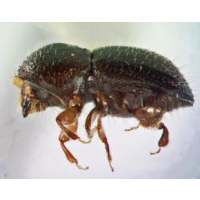Meet the Beetle That Is Decimating Trees Across Southern California
 Female polyphagous shot hole borer (Photo: Gevork Arakelian, L.A. County Agricultural Commissioner)
Female polyphagous shot hole borer (Photo: Gevork Arakelian, L.A. County Agricultural Commissioner)
An uncontrollable beetle from Southeast Asia is spreading through Southern California, boring its way into a wide variety of trees and implanting a deadly fungus for which there is no treatment.
The polyphagous shot hole borer (PSHB) has been around the region since at least 2003, when it was found in the Whittier Narrows of Los Angeles County. It was spotted from time to time in ornamental trees but it didn’t show up on anyone’s radar until 2010, when it was blamed for killing a lot of box elder trees in Long Beach. The beetle is tiny and barely perceptible.
It now appears to be established (pdf) in at least the counties of Los Angeles, Riverside, San Bernardino and, most recently, San Diego. By the summer of 2012, it had attacked more than 200 species of trees, including the native Coast Live Oak and the California sycamore.
The avocado industry first became aware of the threat that year and called on plant pathologist Akif Escalen from the University of California, Riverside for help. The California Avocado Commission has contributed $800,000 to scientists researching the problem.
Unlike termites, the borer does not eat wood. Instead, it drills into the tree carrying fungal spores in its mouth which it deposits at multiple locations deep in the wood. The fungus destroys the tree’s food and water delivery system, while the beetle harvests the fungus to feed its larvae. Although the beetle is small, it makes a hole in the wood noticeable under close inspection.
Not all trees succumb to the attack. Some lose a few branches, others escape unscathed. But if the beetle reproduces and the fungus takes hold, the tree is likely a goner. That happens about 8% of the time, according to UC’s Division of Agriculture and Natural Resources.
Scientists don’t know how to attack the bugs, which are well-protected against pesticide spraying in their wooded enclaves. The incestuous beetles breed among themselves in their self-contained colony and don’t seem attracted to pheromone lures.
The Los Angeles Times reported last week that the beetles have spread to two of the region’s most treasured plant and tree sanctuaries: The Huntington Library, Art Collections and Botanical Gardens and The Los Angeles County Arboretum and Botanic Garden. Escalen and others found the beetle in 207 of 335 species of trees they surveyed. Fifty-four percent of the infested trees had the fungus.
The bug’s DNA has been analyzed and traced to Vietnam. No one knows how it got here and scientists are only now beginning to investigate if the beetle has a natural predator they can import. Officials from the California Department of Food and Agriculture, the avocado commission, scientists from UC Riverside and others gathered in Sacramento on May 27 to discuss the problem.
Escalen told the Times he was optimistic that a solution would be found, but delivered an ominous warning nonetheless: “If we can't control them they are going to wipe out all our trees.”
–Ken Broder
To Learn More:
Tree-Killing Bug Invades Southern California, with No Answer in Sight (by Amina Khan, Los Angeles Times)
Polyphagous Shot Hole Borer (University of California Division of Agriculture and Natural Resources)
Polyphagous Shot Hole Borer (Center for Invasive Species Research)
- Top Stories
- Controversies
- Where is the Money Going?
- California and the Nation
- Appointments and Resignations
- Unusual News
- Latest News
- California Forbids U.S. Immigration Agents from Pretending to be Police
- California Lawmakers Urged to Strip “Self-Dealing” Tax Board of Its Duties
- Big Oil’s Grip on California
- Santa Cruz Police See Homeland Security Betrayal in Use of Gang Roundup as Cover for Immigration Raid
- Oil Companies Face Deadline to Stop Polluting California Groundwater





